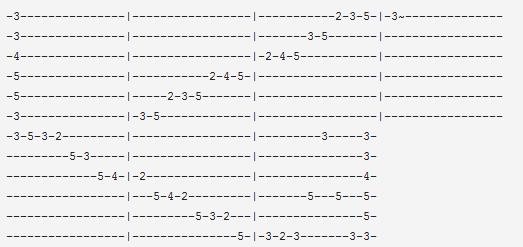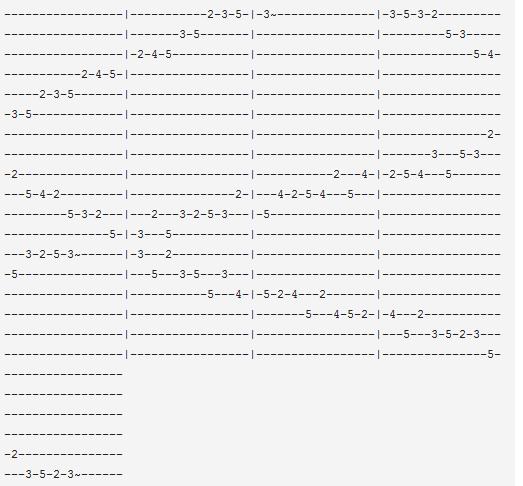Zion Mastering The Major Scale SI Lesson
Contents |
Introduction
My name is David. This is my first Student Instructor lesson, and the current assignment in my MTP.
I am 29 years old, and have been living just outside Copenhagen, Denmark all my life. Last year the girlfriend and I decided to move to Sweden, so this is now our country of residence.
My guitar history began when I was 15 years old, where I first decided to pick it up and learn how to play. Later, my friend and I started a band called V.O.K. (corny, I know). We were less than adequate, but we were having fun, and we even managed to do some recording. Then our drummer decided to quit, and the band died out. Instead of continuing onwards with my guitar career I decided to put it away.
Ten years passed and then something happened. I have no idea what, but I wanted to play again, so I started all over, playing in a new band, and learning loads of new stuff with the help of GMC and my own dedication. This was back in may, 9 months ago.
Enough talk. Let’s get on with the lesson.
Mastering The Major Scale
I might as well say it right now. This lesson will be an exercise, and exercises aren’t always fun. In fact, most of the time it’s so boring we tend to do everything we can to try to skip it. However, exercises needs to be done when learning new scales, and in the end, I believe that it will benefit you in ways you cannot even begin to understand right now. So, hang on, do the exercise, and you will not regret it.
The lesson consists of five exercises (or steps), which will help you get to learn the Major scale. We will be doing it in the Key of G, and the “formula” for the Major Scale is: 2-2-1-2-2-2-1, which, for the Key of G will give us the notes: G-A-B-C-D-E-F#-G.
I will not go into much theory but the formula cannot be told enough times.
Below are the five different “box” shapes for the Major Scale (borrowed with permission from Andrew Cockburn)
For this lesson we will just focus on the first “box” shape, and get to know it really well, so without further ado, let’s get on with it.
EDIT: You should be aware that I made both GP5 files and regular .txt files, which should make it easier to see the tab.. Located at the bottom :)
Step 1: Up & Down
The first step is to ease ourselves into the box. We play it up and down, and try to memorize it. When learning a new scales there are some things that I believe are very important to learn as well:
- The chord shape that lies beneath the “box”
- Knowing where the root notes are located
You will therefore notice that I will start (and finish) the exercise by playing the chord shape that lies beneath the box. In this case it’s the E-shaped G-Major chord (for more information on the CAGED system, visit Andrews’s lesson)
Furthermore you will also notice that after I have gone up and down in the box, I will hit *ALL* the root notes in the “box”, which should help you memorize where they are located.
Step 2: Changing Directions
Now that we know the “box”, we want to spice it up a bit. This is done by changing directions when we go up and down. Where and how often we change direction is entirely up to you.
Step 3: Thirds
To further our knowledge of the “box”, we want to play it as many times as possible but also change the way we play it. In this step we do it in thirds.
Step 4: Four In A Row
Another way of playing the “box” is to do 4-in-a-row, which is what we will be learning now.
Step 5: Random Notes
Now that we are getting very aware of how the “box” looks and sounds, it’s time to see if we can forget about the box and “break” out. This last step is all about trying to free our mind of the “box” shape thinking and begin to open it up. We do this by hitting random notes in the scale. It is EXTREMELY important that you only hit notes that are within the scale, so make sure you only hit those notes.
There you have it. You should now have great knowledge of the first “box” shape. If you are having problems playing any of the videos slow down the tempo until you can do it properly, and then turn it up again. Always begin slowly until you really nail it.
Where to go next?!
Now that you know the first box very well, where do you go next? Well, I have tried to make a plan on how to proceed from here, and this is what I would do.
Try to create some licks in the first box
Do the above exercises for the second box
Try to create some licks in the second box
Learn how to connect the boxes
Repeat 2, 3 and 4 with box 3, 4 and 5
I would suggest spending at least 1 week on each “box” shape, and maybe a week more (depending on how much you practice each day) on trying to connect the newly learned box with the previous one. This should really help you imprint the major scale on the fretboard, and within two months you should be pretty confident when playing it.
I hope you’ve enjoyed my first SI lesson. Please don’t hesitate to ask me if you have any questions or need some help with something.
Special thanks goes to:
- Smells for helping me out with lesson quality
- Andrew for letting me borrow the images from his lesson
Practice hard and rock on :)














